Something i couldn’t understand happened at the last Venice Biennale. I had read that
Emily Jacir‘s public intervention Stazione would have seen the 24 piers for the Route 1 water bus (the vaporetto that starts at the Lido stop and ends at Piazzale Roma) display the names of the stops in Arabic as well as the usual Italian, creating a bilingual transportation route up and down the Grand Canal. Yet, i saw none of that in Venice. At the time, I couldn’t find any article in the press clarifying its absence either.
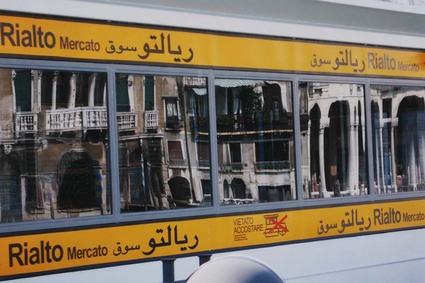 Emily Jacir, stazione, Rialto Mercato, 2009
Emily Jacir, stazione, Rialto Mercato, 2009
Turns out that the work was -to put it diplomatically- canceled. Without any explanation.
Yet the Biennale had at first approved the project and so did the council and the vaporetto company. All the artist could find out, second-hand, was that the company had ‘received pressure from an outside source to shut it down for political reasons’. The company claimed that the problem was with the city authorities in Venice. Jacir, who had won a Golden Lion at the Venice biennale two year earlier, spoke to the vaporetto company in person but she couldn’t get any clear answers. ‘Oddly,’ she told Art Monthly, ‘the man I spoke with mentioned the attacks on Gaza last December and said that this played a role in shutting down the project as it made the parties involved in the project nervous. I find that completely bizarre, as the work has nothing to do with Gaza.’
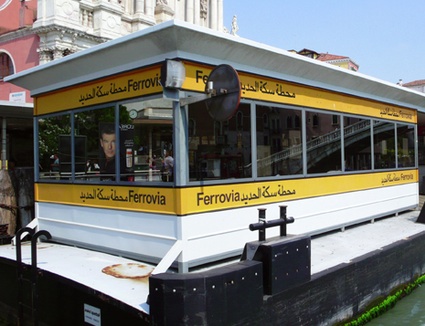 Emily Jacir, stazione, Ferrovia, 2009
Emily Jacir, stazione, Ferrovia, 2009
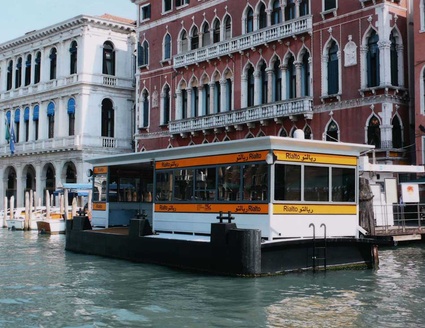 Emily Jacir, stazione, Rialto, 2009
Emily Jacir, stazione, Rialto, 2009
The work was indeed peaceful, it was meant to illustrate cultural exchanges through history. Jacir is an artist of Palestinian descent, she lives and works in Ramallah and New York and Stazione was her contribution to the official off-site exhibition, Palestine c/o Venice. The arabic inscriptions would have placed each floating platform in direct dialogue with the surrounding architecture and urban design, linking them with various elements of Venice’s shared heritage with the Arab world.
Jacir was only allowed to distribute a map in Italian, Arabic and English of the number 1 route. It contains a map of the location of the project, as well as the Vaporetto map translated into Arabic and a brief explanation of the background to the piece. However, she was forbidden by Palestine c/o Venice organizers to include a text describing the cancellation of her project by the Venetian Municipal Authorities. She was only permitted to include the following note: THIS PROJECT HAS BEEN CANCELLLED.
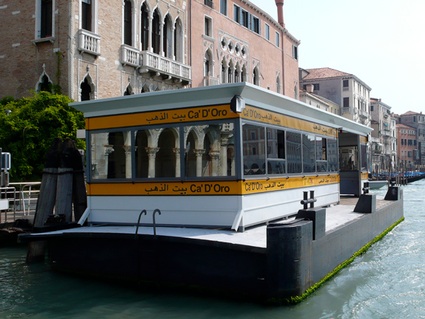 Emily Jacir, stazione, Ca’ D’Oro, 2009
Emily Jacir, stazione, Ca’ D’Oro, 2009
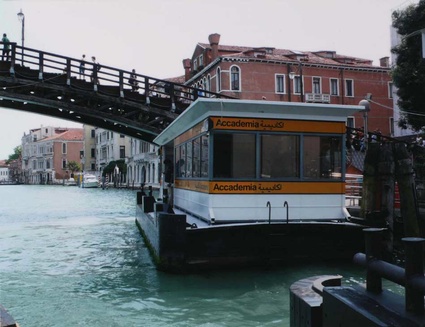 Emily Jacir, stazione, Accademia, 2009
Emily Jacir, stazione, Accademia, 2009
The architecture on either side of the Grand Canal testifies to bonds that have connected Venice with the Arab world over the centuries. By placing translations of the stations on either side of the Grand Canal, Emil Jacir would have prompted tourists and Venetians to reflect on these bygone relationships, age-old cultural and mercantile exchanges, and forgotten legacies (glass blowing was invented in Palestine and the first Arab book with Arabic characters was printed in Venice) as they crossed to ‘the other bank’. Stazione was hoping to demonstrate that the barrier between two spaces that are considered different, even counterpoised, can be crossed.
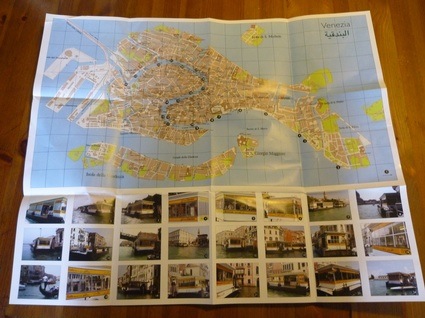
The Alberto Peola Gallery in Turin is exhibiting the proposal digitally retouched photographs that show what stazione would have looked like. The gallery is also exhibiting other works by the artist and distributing copies of the map that Jacir distributed during the Biennale.
Stazione is on view at the Alberto Peola Gallery in Turin until Saturday 24 April 2010
Interview with the artist in the New York Times.
